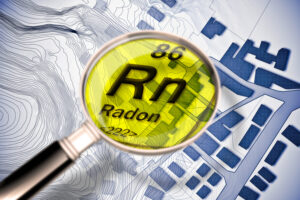 Radon is a naturally occurring, radioactive gas that is estimated to be present in one out of every 15 U.S. homes in the United States. It is colorless, tasteless and odorless, and can result in serious adverse health effects – in fact, it is the second-leading cause of lung cancer in the United States next to smoking, according to the U.S. Surgeon General.
Radon is a naturally occurring, radioactive gas that is estimated to be present in one out of every 15 U.S. homes in the United States. It is colorless, tasteless and odorless, and can result in serious adverse health effects – in fact, it is the second-leading cause of lung cancer in the United States next to smoking, according to the U.S. Surgeon General.
Although only some states have laws about testing and disclosing a property’s levels, unacceptable levels of can inhibit efforts to sell, transfer or finance a property, and can expose a property owner to resident complaints and inhabitability claims. Fortunately, even very high levels of radon can be effectively remediated.
Download Printable Article (PDF) >>>
Testing for Radon
The Environmental Protection Agency (EPA) recommends testing under the following circumstances:
• The building has never been tested.
• The building has not been tested in two years.
• The building was renovated since it was last tested.
• The building was tested on a higher level than you plan to occupy.
You can either test yourself or call a qualified professional. The testing method used depends on your needs and time constraints. Testing can be passive (using charcoal canisters or alpha-track detectors) or active (using continuous radon monitors). Passive methods are readily available at hardware stores, while active methods are typically performed by testing professionals.
What is a Typical or Acceptable Level?
The average indoor radon level is 1.3 pCi/L, and the average outside radon level is .4 pCi/L. While the action level established by the EPA is 4 pCi/L or more, that of the World Health Organization (WHO) is as low as 2.7 pCi/L. Remediation can be considered between 2 and 4 pCi/L.
How Can I Remediate It?
The right remediation method depends on various factors, including building design, construction
materials and other factors. Typical methods of remediation are sealing cracks and other openings
in the foundation and the installation of a vent and fan system. If the building’s water source has
high levels of radon, a point-of-entry treatment device can be installed to reduce emissions.
Can I Prevent Radon Intrusion?
There are proven radon-resistant building techniques, which both mitigate radon levels and improve building energy efficiency and moisture control, such as the following:
• Gas-permeable layers
• Plastic sheeting
• Sealing and caulking
• Vent pipes
• Junction boxes
These techniques have proven to be more cost efficient than remediating elevated levels of radon in an existing building.



